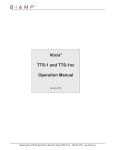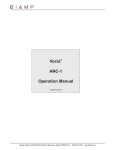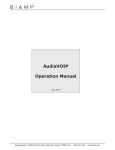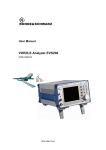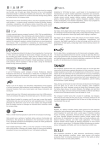Download Biamp VOCIA LSI-16 Specifications
Transcript
Vocia® LSI-16 Operation Manual Biamp Systems, 10074 S.W. Arctic Drive, Beaverton, Oregon 97005 U.S.A. (503) 641-7287 www.biamp.com table of contents Vocia Life Safety Interface 16 (LSI-16) features . . . . . . . . . . . . . . . . . . . . . . . . . . . . . . . 3 front panel. . . . . . . . . . . . . . . . . . . . . . . . . . . . . . . . . . . . . . . . . . . . . . . . . . . . . . . . . . . . . . . . . . . . . . . . . . . . . . . . 4-5 Setup and Use. . . . . . . . . . . . . . . . . . . . . . . . . . . . . . . . . . . . . . . . . . . . . . . . . . . . . . . . . . . . . . . . . . . . . . . . . . . . . . . . . . 4 Front Panel . . . . . . . . . . . . . . . . . . . . . . . . . . . . . . . . . . . . . . . . . . . . . . . . . . . . . . . . . . . . . . . . . . . . . . . . . . . . . . . . . . . . 4 (1) Power . . . . . . . . . . . . . . . . . . . . . . . . . . . . . . . . . . . . . . . . . . . . . . . . . . . . . . . . . . . . . . . . . . . . . . . . . . . . . . . . . . . . . . 4 (2) General Alarm. . . . . . . . . . . . . . . . . . . . . . . . . . . . . . . . . . . . . . . . . . . . . . . . . . . . . . . . . . . . . . . . . . . . . . . . . . . . . . . . 4 (3) General Fault . . . . . . . . . . . . . . . . . . . . . . . . . . . . . . . . . . . . . . . . . . . . . . . . . . . . . . . . . . . . . . . . . . . . . . . . . . . . . . . . 4 (4) Power Supply Fault. . . . . . . . . . . . . . . . . . . . . . . . . . . . . . . . . . . . . . . . . . . . . . . . . . . . . . . . . . . . . . . . . . . . . . . . . . . 4 (5) Protection Fault. . . . . . . . . . . . . . . . . . . . . . . . . . . . . . . . . . . . . . . . . . . . . . . . . . . . . . . . . . . . . . . . . . . . . . . . . . . . . . 4 (6) Path Fault. . . . . . . . . . . . . . . . . . . . . . . . . . . . . . . . . . . . . . . . . . . . . . . . . . . . . . . . . . . . . . . . . . . . . . . . . . . . . . . . . . . 4 (7) System Fault . . . . . . . . . . . . . . . . . . . . . . . . . . . . . . . . . . . . . . . . . . . . . . . . . . . . . . . . . . . . . . . . . . . . . . . . . . . . . . 4-5 (8–15) Zone Alarm/Option Slot and (16–23) Zone Fault/Option Slot. . . . . . . . . . . . . . . . . . . . . . . . . . . . . . . . . . . . . . . 5 rear panel. . . . . . . . . . . . . . . . . . . . . . . . . . . . . . . . . . . . . . . . . . . . . . . . . . . . . . . . . . . . . . . . . . . . . . . . . . . . . . . . . 6-11 Device ID . . . . . . . . . . . . . . . . . . . . . . . . . . . . . . . . . . . . . . . . . . . . . . . . . . . . . . . . . . . . . . . . . . . . . . . . . . . . . . . . . . . . . . 6 Network Connection. . . . . . . . . . . . . . . . . . . . . . . . . . . . . . . . . . . . . . . . . . . . . . . . . . . . . . . . . . . . . . . . . . . . . . . . . . . 6-7 Monitored Outputs . . . . . . . . . . . . . . . . . . . . . . . . . . . . . . . . . . . . . . . . . . . . . . . . . . . . . . . . . . . . . . . . . . . . . . . . . . . . . . 8 Sounder Outputs/Silence Input. . . . . . . . . . . . . . . . . . . . . . . . . . . . . . . . . . . . . . . . . . . . . . . . . . . . . . . . . . . . . . . . . . . . 8 System Fault Reset Input. . . . . . . . . . . . . . . . . . . . . . . . . . . . . . . . . . . . . . . . . . . . . . . . . . . . . . . . . . . . . . . . . . . . . . . . . 8 System Test. . . . . . . . . . . . . . . . . . . . . . . . . . . . . . . . . . . . . . . . . . . . . . . . . . . . . . . . . . . . . . . . . . . . . . . . . . . . . . . . . . . . 9 Voice Active Alarm . . . . . . . . . . . . . . . . . . . . . . . . . . . . . . . . . . . . . . . . . . . . . . . . . . . . . . . . . . . . . . . . . . . . . . . . . . . . . . 9 General Fault, PSU Fault, Protection Fault, and Path Fault . . . . . . . . . . . . . . . . . . . . . . . . . . . . . . . . . . . . . . . . . . . . . 9 Control Inputs. . . . . . . . . . . . . . . . . . . . . . . . . . . . . . . . . . . . . . . . . . . . . . . . . . . . . . . . . . . . . . . . . . . . . . . . . . . . . . . . . 10 PSU Fault. . . . . . . . . . . . . . . . . . . . . . . . . . . . . . . . . . . . . . . . . . . . . . . . . . . . . . . . . . . . . . . . . . . . . . . . . . . . . . . . . . . . . 10 Ethernet Fault . . . . . . . . . . . . . . . . . . . . . . . . . . . . . . . . . . . . . . . . . . . . . . . . . . . . . . . . . . . . . . . . . . . . . . . . . . . . . . . . . 10 Voice Alarm Silence from CIE. . . . . . . . . . . . . . . . . . . . . . . . . . . . . . . . . . . . . . . . . . . . . . . . . . . . . . . . . . . . . . . . . . . . . 10 Voice Alarm Reset from CIE. . . . . . . . . . . . . . . . . . . . . . . . . . . . . . . . . . . . . . . . . . . . . . . . . . . . . . . . . . . . . . . . . . . . . . 10 Emergency Detection System Alarm. . . . . . . . . . . . . . . . . . . . . . . . . . . . . . . . . . . . . . . . . . . . . . . . . . . . . . . . . . . . . . . 10 Option Slot. . . . . . . . . . . . . . . . . . . . . . . . . . . . . . . . . . . . . . . . . . . . . . . . . . . . . . . . . . . . . . . . . . . . . . . . . . . . . . . . . . . . 11 System Fault Relay Connection. . . . . . . . . . . . . . . . . . . . . . . . . . . . . . . . . . . . . . . . . . . . . . . . . . . . . . . . . . . . . . . . . . . 11 RS232. . . . . . . . . . . . . . . . . . . . . . . . . . . . . . . . . . . . . . . . . . . . . . . . . . . . . . . . . . . . . . . . . . . . . . . . . . . . . . . . . . . . . . . . 11 24V DC Connector and LED. . . . . . . . . . . . . . . . . . . . . . . . . . . . . . . . . . . . . . . . . . . . . . . . . . . . . . . . . . . . . . . . . . . . . . 11 IP30 Compliance. . . . . . . . . . . . . . . . . . . . . . . . . . . . . . . . . . . . . . . . . . . . . . . . . . . . . . . . . . . . . . . . . . . . . . . . . . . . . . . 11 installation. . . . . . . . . . . . . . . . . . . . . . . . . . . . . . . . . . . . . . . . . . . . . . . . . . . . . . . . . . . . . . . . . . . . . . . . . . . . . . . . . 12 specifications & block diagram. . . . . . . . . . . . . . . . . . . . . . . . . . . . . . . . . . . . . . . . . . . . . . . . . . . . 13 warranty . . . . . . . . . . . . . . . . . . . . . . . . . . . . . . . . . . . . . . . . . . . . . . . . . . . . . . . . . . . . . . . . . . . . . . . . . . . . . . . . . . . . 14 2 Vocia Life Safety Interface 16 (LSI-16) The LSI-16 is a networked device that serves as an interface between a Vocia system and emergency or fire alarm systems. The LSI-16 may accept up to three sources of power: main power is from an external, standards compliant, battery backed 24V DC source but the LSI16 can also utilize Power over Ethernet (PoE) delivered via either of its two network ports. The device is equipped with parallel I/O ports for direct interface to fire and emergency control equipment. The LSI-16 uses Ethernet-based control protocols to function within a Vocia system. FEATURES • Parallel I/O ports for direct interface with fire alarm and emergency equipment • Emergency control of four zones • Eight monitored outputs and eight control inputs • Redundant network connection and power supply options • Option module for added control of I/O • Power and data over a single Ethernet cable • Local storage of configuration data • Rotary switches for unit identification • Status LEDs • Rack mountable (1RU) • CE marked and RoHS compliant • Covered by Biamp Systems’ warranty 3 lsi-16 front panel Setup and Use The Vocia software provides an intuitive interface for configuration and programming of the LSI-16. The information supplied by this manual relates to physical connections and assignment. For more details on configuration of the LSI-16, please consult the Vocia Software Help File. The LSI-16 governs the emergency functions of a Vocia system, monitoring and reporting faults and alarm conditions through indicators and the system software. Incorrect configuration, removal, or non-installation of some system elements may result in the LSI-16 reporting a fault or alarm condition. This is normal operation. For correct, fault-free operation, inputs and outputs must be connected to the LSI-16 as detailed below, the LSI-16 must detect that it is the only such device installed in the Paging World, and the system must be correctly configured and correctly operating. Front Panel The LSI-16 features twenty-three LEDs on the front plate (from left to right): (LED 1) Power The first LED on the left will illuminate green if the unit is powered by main or PoE supplies. (LED 2) General Alarm This LED will illuminate red if the LSI-16 receives an alarm signal from an external emergency detection system (e.g. a fire alarm system) via the Alarm inputs to the LSI-16. This LED indicates the general alarm state: 1.Solid red - The LSI-16 has received an alarm signal from an external emergency detection system (e.g. fire alarm system). 2.Flashing red - The LSI-16 has received a general alarm silence from an external emergency detection system (e.g. fire alarm system). (LED 3) General Fault This LED will illuminate yellow if there is a fault in the system that does not affect the delivery of a warning message. (LED 4) Power Supply Fault This LED will illuminate yellow if LSI-16 is operating on a PoE supply but the main 24V supply fails or an external power supply fault is signaled to the LSI-16. (LED 5) Protection Fault This LED will illuminate yellow if a system amplifier channel fails and this failure does not prevent an emergency zone voice announcement. Note: failures that do affect emergency zone voice announcements will result in a system fault. (LED 6) Path Fault This LED will illuminate yellow if a fault in a transmission path is detected. The path integrity is tested from microphone capsule to end of loudspeaker lines if optional Vocia ELD-1 devices are fitted at the end of the loudspeaker lines. (LED 7) System Fault This LED indicates the integrity of the system: 1. Flashing yellow - The unit has a fault that may prevent the reliable operation of life safety announcement functions. 2. Not illuminated - The unit is operational without any faults that may prevent reliable operation of life safety announcement functions. 4 lsi-16 front panel (LED 7) System Fault (continued) Because it indicates a potentially serious condition, the presence of a System Fault extinguishes indicators for PSU, Path and Protection faults so as to focus attention on the primary fault. However, individual PSU, Path and Protection faults are still shown in the system software and signaled to individual fault outputs as described below. The LSI-16 will always power up in the system fault condition. Manual intervention is required to take the LSI-16 out of this condition. Note: this power up condition does not prevent emergency zone voice announcements provided that the system is operating reliably. (LEDs 8–15) Zone Alarm/Option Slot and (LEDs 16–23) Zone Fault/Option Slot These two groups of LEDs indicate functionality of the option slot board, which depends on the type of option module that is fitted to the LSI-16. If no option slot board is installed, these LEDs will remain inactive. 5 lsi-16 rear panel BIAMP SYSTEMS 10 Designed in Australia Assembled in USA YEL: in use GRN :link/act N24138 Option A Device ID 1 2 4 3 5 6 7 9 8 10 11 12 13 14 1 2 3 4 5 6 7 8 9 Option B 10 11 12 13 14 Model LSI-16 24V DC 15W GND 1 PoE IEEE 802.3af Class 3 2 MSB LSB 1 2 5 6 3 4 Monitored Outputs 7 8 10V (100mA) 1 2 3 4 5 Control Inputs 6 7 8 C NC NO System Fault RS232 Power Class 2 or LPS Device ID The rotary ID switches are located on the back of the LSI-16 and give the unit a unique Device ID. The switches are in hexadecimal format. All LSI-16 units must have a unique Device ID to function within a Vocia Paging World (i.e., it is not possible to have two LSI-16 units with the same Device ID of hex 07). To assign a Device ID of hex 07, turn the LSB switch to 7 and leave the MSB switch on 0. To create an ID of hex B7, turn the LSB switch to 7 and turn the MSB switch to B. Device ID switches should be set using a 0.1 inch (2.5mm) to 0.12 inch (3.0mm) flat blade screwdriver. More information on setting IDs and the hexadecimal numbering scheme used in Vocia can be found in the Vocia Help File. Please note: Changes made to the Device ID while connected to the network require a power cycle in order to take effect. Network Connection The LSI-16 has two RJ45 Ethernet connectors. These provide redundant network capability as well as a secondary source of power (PoE). If communication is lost on either Ethernet port, the LSI-16 reports a fault. For this reason, both Ethernet ports must be connected to the Vocia network. To provide Auxiliary power PoE should be supplied to both Ethernet ports. An LED adjacent to each RJ45 connector indicates that PoE is being supplied via that port. The RJ45 connectors utilize standard copper Ethernet cabling to interface the LSI-16 to the Vocia system via a PoE-compliant network switch. The RJ45 connector provides two LEDs that indicate Ethernet link and network activity (see table below). Left LED Right LED Description None None No power or data connectivity. Please check the PoE network connection. Yellow Flashing green Network link established and indicates the port is currently in use. Yellow None There is a network link but the port is redundant. 6 lsi-16 rear panel This connection carries control data and power over a single Ethernet cable. The maximum distance between any unit and an Ethernet switch is 328 feet (100 meters) when using copper cabling. Additional Ethernet switches and/or fiber-optic cable can be used to further extend distances between units on a network. Note: A managed Ethernet switch is required for redundant network wiring (spanning-tree configuration or similar). If non-Vocia network traffic shares an Ethernet switch with the Vocia network, separate VLANs must be established. All Ethernet wiring must be accomplished using shielded CAT5, CAT5e, CAT6, or CAT7 cable. For standards-compliant systems, a managed switch with dry contact fault output is required. LSI-16 BIAMP SYSTEMS 10 Designed in Australia Assembled in USA YEL: in use GRN :link/act N24138 Option A Device ID 1 2 4 3 5 6 7 8 9 10 11 12 13 14 1 2 3 4 5 6 7 8 9 Model LSI-16 Option B 10 11 12 13 14 24V DC 15W GND 1 PoE IEEE 802.3af Class 3 2 MSB 1 LSB 2 5 6 3 4 Monitored Outputs 7 8 10V 1 (100mA) 2 3 4 5 Control Inputs 6 7 8 C NC NO System Fault Power RS232 Class 2 or LPS Ethernet switch with PoE LSI-16 BIAMP SYSTEMS 10 Designed in Australia Assembled in USA YEL: in use GRN :link/act N24138 Option A Device ID 1 2 4 3 5 6 7 8 9 10 11 12 13 14 1 2 3 4 5 6 7 8 9 Model LSI-16 Option B 10 11 12 13 14 24V DC 15W GND 1 PoE IEEE 802.3af Class 3 2 MSB LSB 1 2 5 6 3 4 Monitored Outputs 7 8 10V (100mA) 1 2 3 4 5 Control Inputs 6 7 8 C NC NO System Fault RS232 Power Class 2 or LPS Ethernet switch without PoE PoE injector 7 AC Power lsi-16 rear panel Monitored Outputs Two black five-position connectors are located next to the rotary switches. These are predominantly used for Monitored Outputs to external lamps or sounders. Individual connections are labeled 1 through 8 as indicated below. One connection is configured for use as both an input and an output (1) and one as an input (2) (see table below for connector assignments). Marking Function Ground 1 Sounder Output / Silence Input 2 System Fault Reset Input 3 Voice Alarm Active 4 General Fault 5 PSU Fault 6 Protection Fault 7 Path Fault 8 External Supply Over-voltage Monitor 10V 10V Out The outputs will sink current (pull low) when active (see the Specifications section of this document for more details). The desired load (lamp, LED, etc.) must be connected between the output terminal and a positive voltage reference. It should be noted that external switches and a sounder connected to the first two inputs are typically mandatory for standards compliance. The location and physical attributes of these items may be required to conform with local norms. The switches and sounder must be wired according to the connection diagram provided below. Sounder Output / Silence Input This connection functions as a dual purpose alarm sounder output and silence input (see connection diagram below). Sounder Output This output connects to a local sounder for fault and alarm warnings. A sounder is typically required for standards compliance. Note:If an emergency microphone is located near the sounder, it may be configured in Vocia software to mute the sounder while making live announcements. Silence Input This input is used to silence the local sounder. The sounder will restart in response to any new fault or alarm. System Fault Reset Input This input is required to take the LSI-16 out of System Fault condition. Note: the LSI-16 will always power up in a system fault state (see connection diagram). 8 lsi-16 rear panel System Test A system test can be initiated by simultaneously connecting monitored outputs 1 and 2 to ground (see connection diagram). A system test runs a diagnostic test, part of which illuminates each LED in turn and momentarily activates the sounder. Connection Diagram: External Switches and Sounder (Note: 10V supply may be derived from the LSI-16 Outputs Connector) SW1 System Fault Reset (e.g. EAO 31-453 or equivalent switch) SW2 System Test (e.g. EAO 31-453 or equivalent switch) SW3 Silence Local Sounder (e.g. EAO 31-453 or equivalent switch) D1 and D2 1N4004 or equivalent general purpose 1A diode R1 and R2 22kΩ 0.25 watt resistor S1 Piezo (or similar) sounder - tone and sound pressure level may be required to comply with local norms Voice Alarm Active This output is active when messages are playing in response to an alarm input. This output provides indication of when a message is playing or when a message has been muted. Constant active output - indicates a message is playing in response to an alarm input. Cyclic output (1.25Hz) - indicates the message has been muted. General Fault, PSU Fault, Protection Fault and Path Fault These outputs will be activated by the same alarm conditions as identically named LEDs on the front panel (described above). Note however that these outputs will be activated by the faults listed above irrespective of whether a System Fault has been activated. The Voice Alarm Active, General Fault, PSU Fault, Protection Fault and Path Fault outputs are monitored for open-circuit or short-circuit to ground or power supply and for over-voltage on the output pin (>35V DC). If incorrect conditions are detected a Fault is signaled. Output monitoring facilitates compliance with voice evacuation standards. For each of these outputs, a load must be connected between each output and the positive voltage source. If any output on terminals 1 through 8 is unused, the output must be connected through an external resistor to the positive side of the voltage source (either 10V Out or user-supplied external source). To ensure correct functionality, the value of each resistor should be 22kΩ. An internally derived 10V source is provided at the 10V Out terminal; however, the total current available from this pin is limited to 100mA. This voltage source may be used for external devices provided the total load is less than 100mA. For higher-current devices, a user-supplied external voltage source of up to 35V may be used, with the negative side connected to the pin. Due to monitoring constraints, it is impossible to use both the internal 10V source and an external source. For monitoring purposes, the positive side of the voltage source (either 10V Out or user-supplied external source) must be connected to the External Supply Over-voltage Monitor (terminal 8), as well as supplying voltage to external devices. 9 lsi-16 rear panel Control Inputs Two five-position plug-in barrier strip connectors provide control input connections. Eight separate channels plus two ground pins are provided (see table below for connector assignments). Control inputs are fully isolated from all connections in the LSI-16. Marking Function Ground 1 PSU Fault (contact closure indicates a PSU Fault) 2 Ethernet Fault 3 Voice Alarm Silence from CIE (common for all zones) 4 Voice Alarm Reset from CIE (common for all zones) Ground 5 Emergency Detection System Alarm 1 6 Emergency Detection System Alarm 2 7 Emergency Detection System Alarm 3 8 Emergency Detection System Alarm 4 Input Activation Conditions Control Inputs 1 and 2 To activate an input, it must be connected to an external circuit that returns to either of the two be less than 4kΩ. pins. The resistance of this circuit must Control Inputs 3 to 8 These inputs must be permanently connected to an external circuit that returns to either of the two pins. The resistance of this circuit must be between 1kΩ and 4kΩ. To activate an input, pull the input to a voltage between 12 and 24V. PSU Fault This input may be derived from the primary 24V power supply to indicate to the LSI-16 if there is a fault in the power supply. This may be required for standards compliance. Ethernet Fault This input can be derived from an Ethernet switch to monitor the Ethernet network connection between the LSI-16 and amplifier. This may be required for standards compliance. Voice Alarm Silence from CIE (fire alarm system) This input is a signal from the CIE (fire alarm system) that will mute emergency messages in all emergency zones. Voice Alarm Reset from CIE (fire alarm system) This input is a signal from the CIE (fire alarm system) that will reset emergency messages in all emergency zones. Emergency Detection System Alarm These four inputs are used to connect to the fire alarm control and indicating equipment (CIE) and notify the LSI-16 that an alarm has occurred on a particular zone. Four such zone inputs may be connected. Additional zone inputs will be available through the option module. When an alarm is detected, the Vocia system will enter Emergency Mode as configured for that input. During Emergency Mode, some or all of the Vocia system will cease normal operation and operate as programmed for the emergency. 10 lsi-16 rear panel Option Slot The option slot allows for additional modules if required by the system design. A typical option module in this slot may provide eight additional general purpose logic inputs, plus eight general purpose logic outputs. System Fault Relay Connection This relay is activated when the LSI-16 is fully operational. It may be used for informing external devices about the LSI-16’s operating conditions or sounding an alarm that indicates the LSI-16 is not functioning reliably. RS232 This port may be used for RS232 communication with the LSI-16 under special circumstances. Future implementations may provide enhanced features via this port. 24V DC Connector and LED This is the primary (main) power supply input for the LSI-16 and as such must be fed from a suitable source of 24V DC capable of 15 watts (625mA). The 24V DC supply has to be sourced separately. In typical installations, this supply will be provided from a power supply compliant with local norms and required standards (typically battery-backed). The adjacent LED indicates the presence of power. IP30 Compliance The LSI-16 is designed for ingress protection to the IP30 standard. In order to maintain this compliance, any unused terminal connectors on the back of the unit must be fitted with the supplied terminal blocks. 11 lsi-16 installation Installation The LSI-16 requires one 1.75 inches (44.45mm) high and 19 inches (483mm) wide rack space with 10 inches (254mm) depth. Mounting the unit using four screws with washers will prevent marring of the front panel. PVC or nylon washers are appropriate. Please install the unit away from heat sources, such as vents and radiators, and in rooms with adequate ventilation. Ensure that air can circulate freely behind, beside, and above the unit. Do not exceed the maximum ambient operating temperature of 32-113 degrees F (045°C). Be aware of conditions in an enclosed rack that may cause the temperature to exceed ambient room conditions. Note: To operate correctly, the LSI-16 requires input and output connections to external components and devices as described in this manual. 12 lsi-16 specifications Life Safety Interface 16 SPECIFICATIONS System Fault Relay: Type: Single ‘Form C’ voltage-free SPST change-over contact Load: Maximum operating voltage: Maximum operating current: Maximum switching capacity: Minimum permissible load: Resistive 125VAC, 60VDC 600mA AC, 1A DC 37.5VA, 30W 10µA @ 10mVDC Parallel Control Inputs: Number: Type: Cathode presented at input – pull low to enable. Sink Current: Min: Max: Maximum Terminal Voltage: Isolation: Parallel Control Outputs: Number: Type: Eight Opto Isolator LED 1mA 6mA 24V 3kV RS232 Port Type: Baud Rate: DTE 57600 Connection: RJ45 with shielded Ethernet/PoE cable (Cat5, Cat5e, Cat6, or Cat7) Power: Main: PoE: 24V DC 15W 802.3af Class 3 Base Dimensions: Height: Width: Depth: 1.75 inches (44.5mm) 19 inches (483mm) 10 inches (254mm Weight: Eight FET switch, open drain (low side driver) Maximum Continuous Current: Current Limit: Maximum External Supply: VMon Input Shutdown: 0.35A 0.8A 35V 35V Approx 6.4 lbs. (2.8kg) Ambient Operating Temperature Range: Compliance: 32-113 degrees F (0-45 degrees C) EU Directive 2002/95/EC, RoHS directive CE marked Life Safety Interface 16 Block Diagram LEDs Control Inputs ID Switches Control Outputs HostProcessor Option Slot PoE 24V DC Vocia System control data 585.0245.90A 13 LSI-16 warranty BIAMP SYSTEMS IS PLEASED TO EXTEND THE FOLLOWING 5-YEAR LIMITED WARRANTY TO THE ORIGINAL PURCHASER OF THE PROFESSIONAL SOUND EQUIPMENT DESCRIBED IN THIS MANUAL 1. BIAMP Systems warrants to the original purchaser of new products that the product will be free from defects in material and workmanship for a period of 5 YEARS from the date of purchase from an authorized BIAMP Systems dealer, subject to the terms and conditions set forth below. 2 If you notify BIAMP during the warranty period that a BIAMP Systems product fails to comply with the warranty, BIAMP Systems will repair or replace, at BIAMP Systems’ option, the nonconforming product. As a condition to receiving the benefits of this warranty, you must provide BIAMP Systems with documentation that establishes that you were the original purchaser of the products. Such evidence may consist of your sales receipt from an authorized BIAMP Systems dealer. Transportation and insurance charges to and from the BIAMP Systems factory for warranty service shall be your responsibility. 3. This warranty will be VOID if the serial number has been removed or defaced; or if the product has been altered, subjected to damage, abuse or rental usage, repaired by any person not authorized by BIAMP Systems to make repairs; or installed in any manner that does not comply with BIAMP Systems’ recommendations. 4. Electro-mechanical fans, electrolytic capacitors, gooseneck microphones, cords connecting handheld microphones, hard-drives, displays, and normal wear and tear of items such as paint, knobs, handles, keypads and covers are not covered under this warranty. All server-based devices are warranted for 3 years only. 5. This warranty is in lieu of all other warranties, expressed or implied. Biamp Systems disclaims all other warranties, expressed or implied, including, but not limited to, implied warranties of merchantability and fitness for a particular purpose. 6. The remedies set forth herein shall be the purchaser’s sole and exclusive remedies with respect to any defective product. 7. No agent, employee, distributor or dealer of BIAMP Systems is authorized to modify this warranty or to make additional warranties on behalf of BIAMP Systems. Statements, representations or warranties made by any dealer do not constitute warranties by BIAMP Systems. BIAMP Systems shall not be responsible or liable for any statement, representation or warranty made by any dealer or other person. 8. No action for breach of this warranty may be commenced more than one year after the expiration of this warranty. 9. BIAMP Systems shall not be liable for special, indirect, incidental, or consequential damages, including lost profits or loss of use arising out of the purchase, sale, or use of the products, even if biamp Systems was advised of the possibility of such damages. 14 compliance 15 compliance 16

















